The Google Ads Trust Crisis: What Court Documents Reveal About the Platform We All Depend On
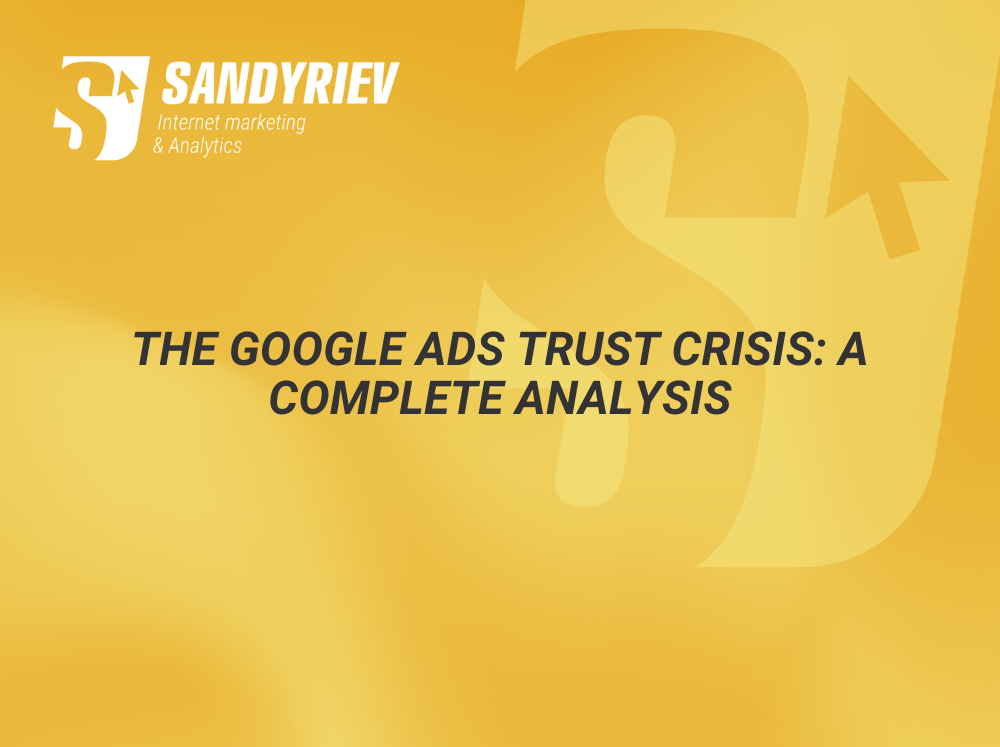
A comprehensive analysis of the declining trust in Google Ads, backed by legal documents, industry research, and expert insights from 2020-2025 Introduction: The Platform That Changed Everything Google Ads transformed digital marketing. For over two decades, it has been the backbone of countless businesses, the first recommendation of marketing consultants, and the primary driver of Google’s $307 billion annual revenue. Yet something fundamental is shifting in how professionals view this platform. In 2025, a landmark study revealed that 54% of PPC experts report declining trust in Google Ads — the steepest drop among all major advertising platforms. This isn’t just about user interface changes or new features that take time to understand. Court documents, internal communications, and regulatory investigations paint a picture of systematic practices that may explain why seasoned professionals are questioning a platform they’ve relied on for years. This analysis examines what’s behind this trust crisis, what court cases have revealed about Google’s advertising practices, and what it means for the future of digital marketing. The Trust Erosion: By the Numbers Industry-Wide Patterns Recent research from Search Engine Land and other industry sources reveals troubling trends: 54% of PPC experts report decreased trust in Google Ads (2024-2025) 86% of industries experience rising advertising costs Cost per lead increased 5.13% to $70.11 across sectors 99% of specialists now use Smart Bidding (limited alternatives) Performance Max adoption exceeds 90% of eligible accounts The Transparency Problem Professional marketers consistently report similar concerns: Inability to verify targeting accuracy Lack of search term visibility in automated campaigns Unclear ad placement reporting Audience signal effectiveness uncertainty Attribution model changes without clear communication What the Courts Uncovered Cabrera v. Google LLC: The $100 Million Settlement Case Duration: 2011-2025 (14 years) Settlement Amount: $100 million Evidence Volume: 910,000+ pages of documents This class-action lawsuit, reaching preliminary settlement approval in March 2025, provides the most comprehensive look into Google’s advertising practices to date. Key Allegations Substantiated: Smart Pricing Manipulation: Google allegedly modified the Smart Pricing formula to reduce advertiser discounts artificially Geographic Targeting Violations: Charges for clicks outside specified geographic zones Billing Irregularities: Systematic overcharging through algorithmic adjustments What the Documents Revealed: The discovery process uncovered internal communications showing: Revenue optimization taking precedence over advertiser transparency Algorithm changes designed to increase spending rather than improve performance Limited internal oversight of billing accuracy systems Project “Momiji”: The Secret Revenue Boost Timeline: 2017-2019 Impact: 15% increase in click costs Internal Codename: “Momiji” (Japanese for “autumn leaves”) Internal Google documents, revealed during Department of Justice antitrust proceedings, detailed Project Momiji — a systematic effort to increase advertising revenue through algorithm modifications. How It Worked: Secret adjustments to auction algorithms Increased bid competition through artificial scarcity Modified quality score calculations “Revenue smoothing” across quarters Internal Communications: Email exchanges between senior Google Ads executives discussed “shaking the couch cushions” to find additional revenue, with specific mention of algorithm tweaks that would be “invisible to advertisers” while boosting company earnings. The Adalytics YouTube Investigation Research Period: 2022-2023 Brands Affected: 1,100+ major advertisers Estimated Losses: $13 billion Independent research firm Adalytics conducted the largest-scale analysis of YouTube advertising placements, revealing systematic discrepancies between promised and actual ad delivery. Key Findings: 80% of video campaigns violated Google’s own service standards Ads promised as “premium YouTube placements” appeared as: Muted autoplay videos on external websites Banner-sized videos on low-quality content sites Ads on websites violating brand safety guidelines Brand Impact: Major advertisers including Johnson & Johnson, Samsung, and Disney+ discovered their premium video budgets were funding placements they would never have approved, leading to widespread campaign pauses and budget reallocations. The DOJ Antitrust Cases Case 1: Search Monopoly (Decided August 2024) Ruling: Google found guilty of illegal monopolization Key Evidence: $26.3 billion annually spent on default search placement Impact: Forced structural changes pending Case 2: Ad Tech Monopoly (Decided April 2025) Ruling: Google holds illegal monopolies in ad tech Scope: Publisher ad servers, ad exchanges, demand-side platforms Remedy Phase: September 2025 trial for forced asset sales Internal Documents from DOJ Cases: David Rosenblatt (Former VP, Google Display): “We’ll be able to crush the other networks and that’s our goal… We’re going to do to display what Google did to search.” Jerry Dischler (President, Google Ads): Internal emails discussed multiple “revenue optimization” projects, including: Auction manipulation techniques Advertiser spend acceleration programs Algorithm modifications to increase platform dependency The Technical Reality: What Can’t Be Verified Targeting Accuracy The Promise vs. Reality: Modern Google Ads targeting operates on what Google calls “intent signals” rather than strict demographic or behavioral criteria. When advertisers select “recently opened business owners,” they’re essentially submitting a request that Google interprets through its algorithms. What Advertisers Can’t Verify: Whether selected audiences actually match targeting criteria How Google defines “interest” in business ownership What percentage of impressions reach the intended audience Whether audience expansion occurs without notification Industry Testing: Independent studies by marketing agencies consistently show: 20-40% variance in expected vs. actual audience characteristics Significant traffic from outside specified demographics Limited correlation between audience settings and actual visitor profiles Performance Max: The Ultimate Black Box What Marketers Know: Total spend and conversions General performance trends Asset performance ratings (limited) What Remains Hidden: Specific ad placements across Google’s network Search terms triggering ads Individual creative performance Audience segment breakdowns Cross-channel attribution details Real-World Impact: Marketing professionals report managing Performance Max campaigns feels like “flying blind” — results may be positive, but optimization requires guesswork rather than data-driven decisions. The Economics of Declining Transparency Rising Costs Across Industries 2024-2025 Cost Increases by Sector: Legal Services: +8.2% (highest CPC sector) Insurance: +6.8% Technology/Software: +5.9% Healthcare: +5.4% E-commerce: +4.8% Professional Services: +4.2% The Automation Tax As Google pushes advertisers toward automated solutions, several cost factors emerge: Smart Bidding Premiums: 15-20% higher average CPCs compared to manual bidding Reduced ability to optimize for specific KPIs Limited cost control during high-traffic periods Performance Max Requirements: Higher minimum budgets for campaign viability Forced expansion into display/YouTube (varying quality) Reduced granular control over spend allocation Alternative Platforms: The Diversification Movement Microsoft Ads: The
The Truth About Social Media Advertising: Debunking the Organic Reach Suppression Myth
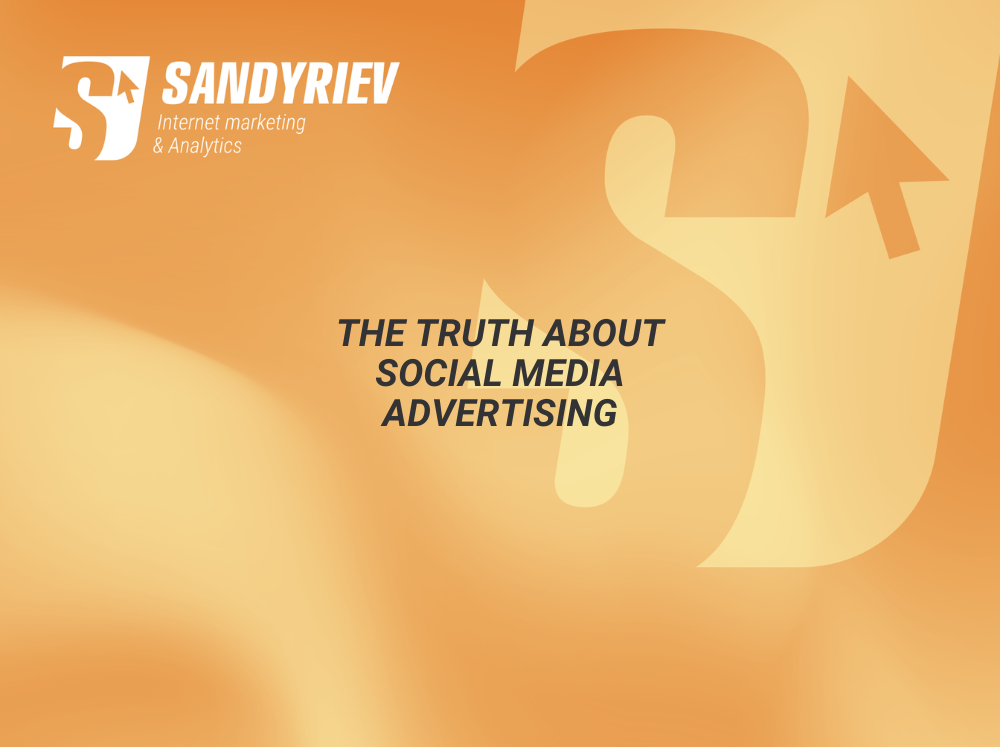
⚡ Bottom Line in 30 Seconds: Paid advertising does NOT suppress organic reach — this is a myth. Organic reach has declined independently due to algorithm changes and content saturation. Facebook shows only 1.37% to followers, Instagram 4%, but this isn’t “punishment” for advertising. Platforms have simply shifted to pay-to-play models. The Research That Sets the Record Straight In 2025, the question of paid advertising’s impact on organic reach has become critically important for marketers. After comprehensive research across industry sources, platform statements, and documented case studies, the evidence shows: organic reach decline is universal and structural, not caused by paid advertising penalties. Shocking Organic Reach Numbers for 2025: Facebook: 1.37% (down from 16% in 2012) Instagram: 4.0% (12-18% year-over-year decline) TikTok: from 24% to 10% over two years LinkedIn: 6.4% for posts, 2% for company pages X (Twitter): 3% of followers see posts Key Findings from Expert Research ✅ What’s Confirmed by Facts: No platform officially penalizes for advertising — confirmed by Instagram, TikTok, YouTube executives Organic reach is declining for everyone, regardless of ad spend Hybrid strategy (organic + paid) shows better results than either approach alone Paid and organic algorithms operate independently ❌ Debunked Myths: “Start advertising and organic reach drops” — FALSE “Platforms punish those who don’t pay” — FALSE “Stop advertising and organic will recover” — FALSE “Organic reach is dead” — EXAGGERATION What’s Really Happening on Each Platform Instagram: Official Myth Debunking Executive Statement: Adam Mosseri (Instagram CEO) stated in January 2025: “The algorithm does NOT suppress post reach because they’re ads or sponsored”. Priority signals are now watch time, likes, and shares. Real Numbers from Case Studies: Tourism company: +189% reach combining organic with minimal boosting Retail brand: +40% impressions using carousels with Stories promotion TikTok: Denying Direct Connection Official Position: TikTok for Business directly answers: “Using Promote does not affect the view count of your other videos”. Documented Results: Analysis of 780,000 videos shows: reach decline happens regardless of advertising GMV Max (organic + paid integration) delivers +30% GMV YouTube: Experiments Disprove Fears Proven by Research: Experiment with 5 million ad-driven views showed — organic views continued growing alongside paid views. Facebook: Pay-to-Play Model Direct Meta Statement: “Facebook today is a pay-to-play platform. The more you spend, the more visibility you get”. But this isn’t punishment for advertising — it’s the business model. X (Twitter): Behavioral Factor Unique Aspect: Users often mute accounts after seeing ads, which directly reduces organic audience. ⚠️ Important Nuance: Indirect Impact of Advertising on Organic Reach Advertising can indirectly affect organic reach through audience composition changes. It’s important to understand: paid and organic algorithms do indeed work independently, but new followers acquired through advertising can impact organic metrics of future posts. 🔄 Chain Reaction: Ad post attracts new audience → people subscribe after viewing specific promotional content New followers see subsequent organic posts → but their subscription motivation was different (promotional offer, not general interest in content) Lower engagement with organic content → new followers less likely to like, comment, save regular posts Algorithm sees declining engagement rate → overall statistics deteriorate due to “cold” followers Decreased organic reach → algorithm assumes content became less interesting 📊 Real Practice Example: Before advertising: 1,000 followers, 8% engagement on organic posts (80 interactions) Ad campaign: promotional post about discount attracts +1,000 new followers Next organic post: shown to 2,000 followers, but new ones provide only 2% engagement Result: overall engagement drops to 5% (100 interactions on 2,000 followers) Algorithm reaction: “Content became less interesting” → reduces organic reach 💡 Key Understanding: This isn’t punishment for advertising, but a natural algorithm reaction to audience behavior changes. The algorithm simply sees statistics without knowing the reasons for the change. 🎯 How to Avoid This: Careful targeting — show ads only to interested audiences Quality creative — ensure advertising attracts the right people New audience warming — create content to adapt new followers Audience quality monitoring — track not just quantity, but behavior 💡 Conclusion: Advertising doesn’t “punish” you intentionally, but can change audience dynamics. Understanding this mechanism allows you to control it. Case Studies with Real Numbers Case #1: Tourism + Instagram/Facebook Strategy: 3-5 posts weekly + $20 boosting Facebook Result: +75% reach, +267% leads Instagram Result: +189% reach Case #2: Retail Brand Problem: -30% organic engagement in 3 months Solution: Interactive content + minimal promotion Result: +15% engagement above previous levels Case #3: P&G Experiment Action: Turned off $200M in advertising Result: Sales unchanged — proof of no direct correlation Practical Recommendations for Each Platform Instagram: Creative Content Strategy 📋 Content Mix: ✓ 60% — educational/valuable content ✓ 30% — behind-the-scenes ✓ 10% — promotional 📊 Frequency: ✓ 1-2 feed posts daily ✓ 3-7 Stories daily ✓ 3-5 Reels weekly 💰 Budget: ✓ 60% — organic ✓ 40% — paid TikTok: Entertainment Focus 🎬 Content: ✓ Hook in first 3 seconds ✓ Minimum 2-3 videos weekly ✓ Focus on watch time 📈 Metrics: ✓ Target: 5.96% engagement ✓ CPC: $0.26-$1.50 💰 Distribution: ✓ 50% — content creation ✓ 30% — advertising ✓ 20% — influencers YouTube: SEO + Watch Time 🔍 Optimization: ✓ SEO titles/descriptions ✓ Consistent schedule ✓ Comment engagement 💰 Budget: ✓ 60% — production ✓ 25% — promotion ✓ 10% — SEO tools ✓ 5% — community Checklist: How to Test Advertising’s Impact on Organic Before Launching Ads: [ ] Record baseline metrics for the last 30 days [ ] Note average reach, engagement, CTR [ ] Document posting frequency and content types During Advertising: [ ] Track metrics separately: organic vs paid [ ] Monitor audience quality (time on page, bounces) [ ] Check negative feedback (hides, complaints) After Advertising: [ ] Compare organic metrics to pre-advertising period [ ] Analyze audience quality changes [ ] Assess long-term brand impact Step-by-Step Hybrid Strategy Algorithm Step 1: Current State Audit Analyze metrics for the last 3 months Assess content quality (what works better) Define target audience by platform Step 2: Content Planning Create content plan 70%
Why Top-1 in Google Ads destroys your ROI: 5 hard truths most businesses learn too late
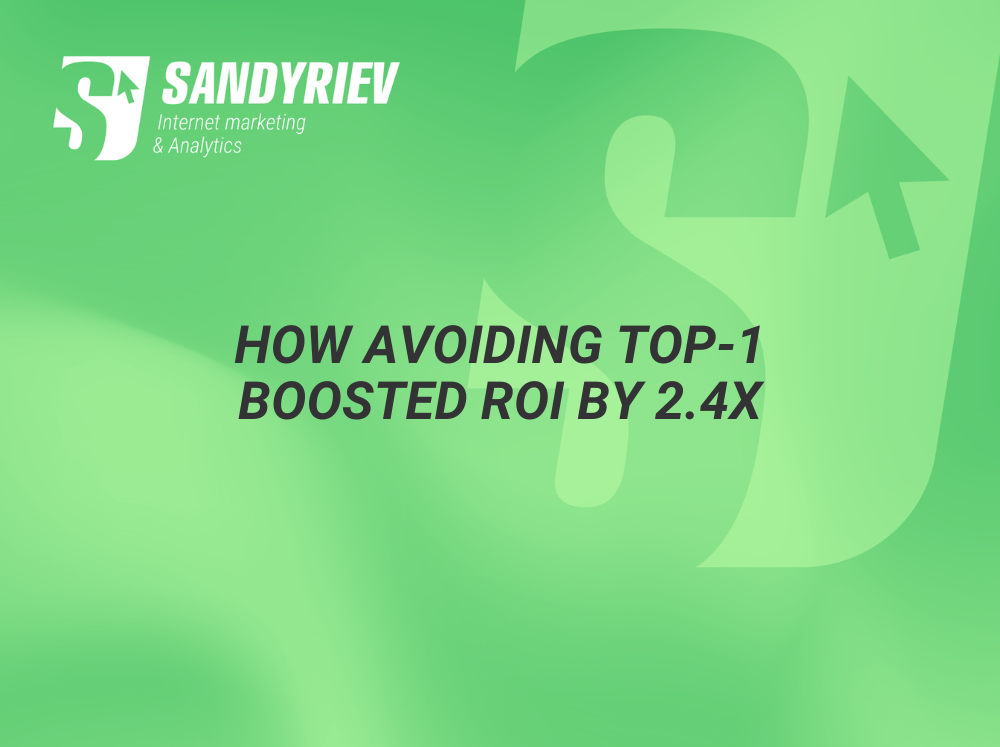
Most businesses chase the wrong goal in Google Ads. They fight tooth and nail for that coveted #1 position, burning through budgets like fuel in a Formula 1 race. But here’s the uncomfortable truth: the goal isn’t getting more orders. It’s maximizing profit. Too many businesses confuse the path with the purpose. More orders ≠ more profit. And as I’ll show you with real data, the relentless pursuit of top positions often destroys the very thing you’re trying to build. The Flawed Logic Most Businesses Follow The reasoning sounds bulletproof: We need more profit More profit comes from more orders More orders come from more clicks More clicks come from top-1 position So let’s bid our way to the top! Sounds logical. It’s not. Where This Logic Breaks Down 1. Higher Position = Lower Intent According to research from AgencyAnalytics, positions 2-4 consistently deliver more qualified traffic than top-1. The reason? Top ads catch everyone. Middle positions catch those who compare and choose. Users who scroll past the first result are typically more motivated and conversion-ready. They’re not just clicking the first thing they see—they’re actively evaluating options. 2. Banner Blindness is Your Quality Filter Studies show that 94% of users ignore search ads entirely, jumping straight to organic results. But here’s the goldmine: the 6% who do click on ads are 50% more likely to make a purchase compared to organic traffic visitors. This “banner blindness” effect actually works in your favor—it filters out casual browsers and delivers genuinely interested prospects. 3. The “Second Look” Effect Google’s internal analysis reveals that users frequently return to middle positions after initially scanning top results. Many scroll down, compare options, then circle back to click on positions 2-4 because these ads often feel more trustworthy and less “oversold.” 4. Mobile Changes Everything On mobile devices, research indicates the gap between positions narrows significantly. While desktop shows a 2x CTR difference between position 1 and 2, mobile shows only ~1.5x difference. Position 2-3 ads on mobile capture nearly as much attention as top spots. 5. Time-of-Day Behavior Patterns Data analysis shows conversion rates drop from 12% during business hours to 3.5% in evening hours, while CPC remains relatively stable. During peak business hours, users click faster and convert immediately—favoring top positions. In the evening, they browse more thoughtfully, giving middle positions better opportunities. Real Case Study: When Strategy Beats Position Let me share real numbers from a recent campaign that proved these principles: Google’s Recommendations: Suggested CPC range: £1.85-£6.35 for top positions Estimated monthly searches: 22,200-5,400 per term Competition level: Medium to High Our Strategic Approach: Actual CPC: £2.37-£2.41 (deliberately bidding at lower end) Top position share: <10-11% (intentionally avoiding #1) Focus on positions 2-4 The Results: Conversion rates: 21.4% – 35.88% (exceptionally high) Cost per conversion: £6.60 – £11.08 CTR: 7.97% – 8.95% (despite lower positions) Cost savings: 52.6% vs bidding for top positions By avoiding the top position trap, this campaign achieved: 2.1x more clicks for the same budget Conversion rates that validate the “quality traffic” hypothesis Sustainable, profitable growth instead of expensive vanity metrics The ROI Reality Check Multiple studies confirm that maximum position ≠ maximum ROI. In many cases, positions 2-4 deliver better return on ad spend because: Lower CPC – Less competition for “good enough” positions Higher intent traffic – Users who scroll and compare are more serious Better budget efficiency – More clicks and conversions per pound spent Sustainable scaling – Profitable growth rather than vanity metrics Industry-Specific Insights B2B vs E-commerce Research shows B2B buyers make 7-12 searches before deciding, making consistent visibility in positions 2-5 more valuable than sporadic top-position appearances. E-commerce, however, often benefits from top positions due to impulse buying behavior. Local Business BrightLocal studies reveal that 70% of local searchers compare multiple businesses before choosing. For local services, being visible in positions 2-4 is often sufficient to capture qualified leads. The Testing Imperative The only way to know what works for your specific business is systematic testing. Industry experts unanimously recommend testing different position strategies rather than blindly following Google’s suggestions. Key metrics to track: ROI/ROAS, not just CTR Cost per acquisition vs volume Customer lifetime value by acquisition channel Profit margins, not just revenue The Bottom Line Top-1 position isn’t the goal—predictable, profitable customer acquisition is. The most successful advertisers focus on: ROI over vanity metrics like position Quality over quantity of traffic Testing over assumptions about what works Profit over volume when budgets are limited Before you burn another pound chasing that #1 spot, ask yourself: Are you optimizing for Google’s revenue or your own profit? The smartest money isn’t always on the top shelf. What’s your experience with ad positioning strategies? Have you found the sweet spot between visibility and profitability? Share your insights in the comments. Sources: AgencyAnalytics – Ad Position Research WebFX – Google Ads Statistics Google Ads Help – Search Ads Relevance Power Digital – Desktop vs Mobile CTR SearchEngineLand – Position vs Conversion Metric Theory – Position Strategy BrightLocal – Consumer Search Behavior
How to Choose Profitable Keywords Using the Adapted RICE Framework for Google Ads
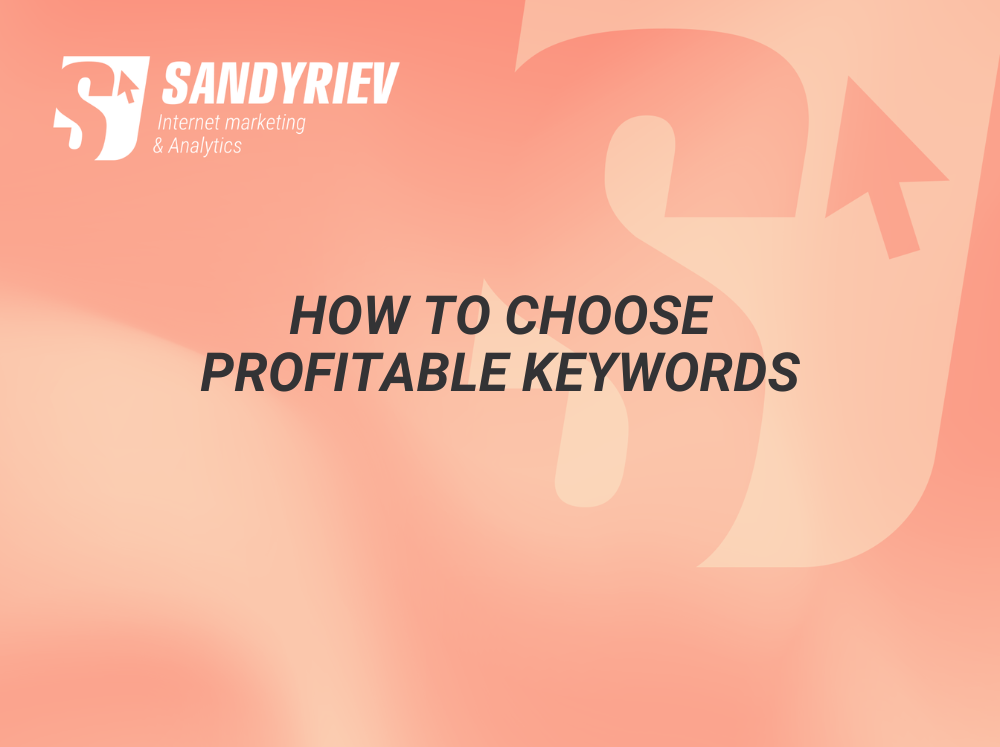
Introduction: Why Your Keywords Are Bleeding Money “I spent $47,000 last year on Google Ads and got 12 new clients. Something’s deeply wrong.” This was Sarah, a skilled family therapist from London, when she first reached out. Beautiful website, active on social media, glowing testimonials—but her Google Ads were a black hole for money. Sound familiar? You pour thousands into keywords that “seem relevant,” chase high search volumes, and wonder why your bank account shrinks while your calendar stays empty. Here’s the brutal truth: most helping professionals choose keywords like throwing darts blindfolded. You’re not failing because Google Ads don’t work—you’re failing because you’re guessing instead of measuring. Today I’ll show you exactly how to stop the guesswork. In the next 15 minutes, you’ll learn a systematic approach that turns keyword selection from gambling into science. No more hoping. No more bleeding money. Just clear, profitable choices. Quick example: Using this method, Sarah cut her keyword list from 847 to 23 words, reduced her monthly spend by 60%, and doubled her new client bookings. Ready to see how? 📌 What is RICE and Why It’s Perfect for Google Ads? RICE is a prioritization framework originally created for product teams. It stands for: Reach — how many people you can impact Impact — how much value you create Confidence — how sure you are about your prediction Effort — how much work it takes The magic formula: (Reach × Impact × Confidence) / Effort Why does RICE crush “gut feeling” methods? Because it forces you to evaluate every keyword across four dimensions simultaneously. No more “this keyword looks good”—you get concrete numbers that predict profitability. I’ve adapted each component specifically for Google Ads and helping professionals. Instead of abstract scores, you’ll use real metrics from Keyword Planner and your actual experience. 🎯 Complete RICE Guide for Google Ads Keywords 📈 1. R – REACH (How Many People You Can Actually Reach) Reach shows your true potential audience for each keyword. But raw search volume tells only half the story—you need to adjust for reality. Here’s how to calculate real Reach: Start with: Monthly Search Volume from Google Keyword Planner Then multiply by these adjustments: Seasonal patterns — because therapy demand changes throughout the year Steady year-round: 1.0 Winter boost (family issues, relationship stress): 1.2 Summer dip: 0.8 Growth trend — is this keyword getting more or less popular? Growing (+20% yearly): 1.2 Stable: 1.0 Declining: 0.8 Device reality — helping professionals search differently Desktop-heavy searches: 1.1 Mobile-heavy: 0.9 Simple calculation: Real Reach = Search Volume × Season × Trend × Device Example: “family psychologists” Search Volume: 570 Season: 1.1 (stable with slight winter increase) Trend: 1.2 (growing – family therapy gaining popularity) Device: 1.1 (desktop preference for serious queries) Real Reach = 570 × 1.1 × 1.2 × 1.1 = 832 💰 2. I – IMPACT (Commercial Value of Each Click) Impact determines how likely each click is to become money in your bank account. Remember: 1,000 clicks from “what is family therapy” are worth less than 100 clicks from “book family therapy session today.” Three parts of Impact: 1. Search Intent (1-10 points): Information seeking (2-3): “what is family therapy”, “family therapy benefits” Researching options (6-7): “family therapy cost”, “best family therapist reviews” Ready to book (9-10): “book family therapy session”, “family therapist appointment now” 2. Location signals (bonus points): “near me” in search: +3 points City/area mentioned: +2 points “online” specified: +1 point No location: 0 points 3. Buyer readiness (1-10 scale): Just learning (“what is family counseling”): 1-3 Comparing options (“family therapy vs marriage counseling”): 4-6 Ready to decide (“book family therapist today”): 7-10 Simple calculation: Impact = (Intent Points + Location Bonus + Readiness) ÷ 3 Example: “book family psychologist appointment” Intent: 10 (transactional – ready to book) Location: 0 (no geographic binding) Readiness: 9 (maximum readiness for action) Impact = (10 + 0 + 9) ÷ 3 = 6.3 🎯 3. C – CONFIDENCE (How Sure You Can Be About Results) Confidence shows how much you can trust your prediction for this keyword. More data and experience = higher confidence = better decisions. Three confidence factors: 1. Historical data quality (40% weight): 12+ months of data: 10 points 6-12 months: 7 points 3-6 months: 5 points Less than 3 months: 2 points Brand new keyword: 1 point 2. Data reliability (30% weight): Exact match historical data: 10 points Phrase match data: 7 points Broad match estimates: 4 points Keyword Planner guesses only: 2 points 3. Your experience (30% weight): Deep helping professions experience: 10 points Some relevant experience: 6 points New to this field: 3 points Calculation: Confidence = (Historical × 0.4) + (Data Type × 0.3) + (Experience × 0.3) Example: You have 8 months of exact match data, strong family therapy niche experience Historical: 7 × 0.4 = 2.8 Data Type: 10 × 0.3 = 3.0 Experience: 10 × 0.3 = 3.0 Confidence = 2.8 + 3.0 + 3.0 = 8.8 ⚙️ 4. E – EFFORT (What It Really Takes to Win) Effort measures how much work and money you need to make this keyword profitable. High effort keywords eat your budget—even if they look attractive. Three effort components: 1. Competition reality (50% weight): Low competition: 2 points Medium: 5 points High: 8 points Extremely high: 10 points 2. Cost reality (30% weight): $0.50-2.00 per click: 2 points $2.00-5.00 per click: 5 points $5.00-10.00 per click: 8 points $10.00+ per click: 10 points 3. Creative requirements (20% weight): Current ads work fine: 1 point Need minor tweaks: 3 points Need new ad copy: 6 points Need dedicated landing page: 10 points Calculation: Effort = (Competition × 0.5) + (Cost × 0.3) + (Creative × 0.2) Example: “best family psychologists” Competition: High (difficulty 100) = 10 Cost: $4.00 per click = 5 Creative: need new ad copy = 6 Effort = (10 × 0.5) + (5 × 0.3) + (6 × 0.2) = 5.0 + 1.5 + 1.2 = 7.7 📊 Putting It All
40% of Your Ad Budget Vanishes. Here’s Where It Goes
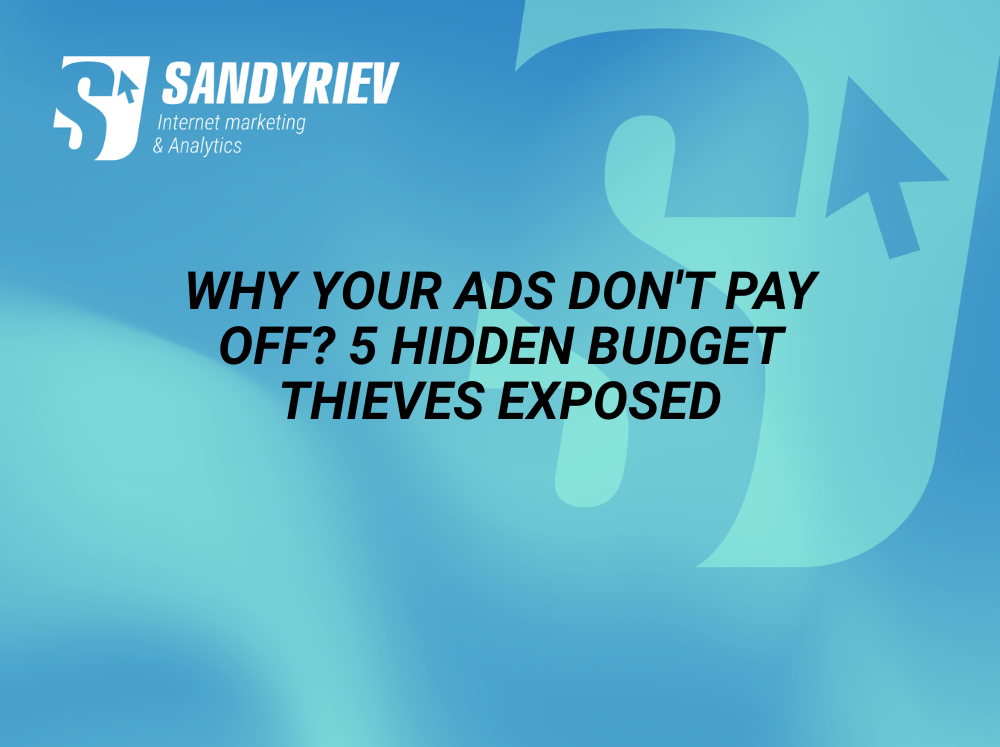
Last week, Alex spent $5,000 on Facebook ads for his online shoe store. His bank account showed 127 sales worth $9,500. But Google Analytics recorded only 78 conversions from Facebook. 49 sales were “invisible” to analytics. Alex thought Facebook wasn’t working. He cut the budget by 50%, but sales dropped even more. The problem persisted. Every month he was missing opportunities to scale profitable advertising. Six months later, Alex was on the verge of bankruptcy. He was undervaluing his best channels due to inaccurate analytics. Now imagine: there are thousands of “Alexes” in the world. And maybe one of them is you. Where Your Money Hides: 5 Invisible Thieves Thief #1: Social Media In-App Browsers (stealing 25-30% of customers) Your customer saw an ad on Facebook mobile and clicked. The site opened not in regular Chrome, but in Facebook’s special built-in browser. What happens next is a disaster: The in-app browser doesn’t pass crucial data: Where the user came from Who they are (cookies don’t work) Their previous activity The customer closes Facebook, an hour later visits your site through Chrome and buys. Analytics records: “New customer from direct traffic.” Your $12 Facebook click “disappears” from attribution. Real case: An electronics store was losing $1,200 monthly due to this issue. The owner thought Facebook wasn’t working and reduced the budget. Sales dropped even further. Thief #2: Ad Blockers (stealing 15-40% of data) 42% of users have AdBlock installed. For them, your site is invisible. A customer comes from ads, buys $120 worth of products, but analytics can’t see them. Scripts are blocked. You pay for advertising but don’t know it works. Even worse — you might reduce budget or turn off a profitable ad campaign because “it’s not generating sales.” Thief #3: The Mysterious “Direct Traffic” Analytics reports have a “Direct” section — supposedly people who typed your URL manually. That’s a lie. 90% of “direct” traffic is actually: Clicks from messengers (WhatsApp, Telegram) Links without UTM parameters Returns from social media Result of ad blockers Shocking fact: One client had 60% of sales in “Direct.” In reality, 80% came from Instagram, but the owner didn’t know this and wasn’t investing in channel development. Thief #4: Fake Sales in Analytics Your analytics shows 100 sales, but your cart shows 73. Where are the other 27? Analytics counts: Canceled orders (customer changed mind) Product returns Employee test purchases Orders without cookie consent The cart only counts real sales. One store owner increased budget by 50%, seeing “sales growth” in analytics. In reality, only returns were growing. Thief #5: The Customer Journey Chain Modern customers don’t buy immediately. Here’s their path: Saw Facebook ad (mobile) Watched YouTube video (tablet) Read Google reviews (laptop) Bought via search (smartphone) Analytics only records the last step. Facebook, which started the entire chain, gets no credit. 5-Minute Test: How Much Money Are You Losing? Step 1: Open your analytics data for last month Step 2: Compare “sales” in Google Analytics with real sales in your CRM/cart Step 3: Check your % of “Direct” traffic If: Difference is over 15% — you’re losing $1,500 from every $10,000 budget “Direct” is over 30% — half of this traffic is actually paid ads You don’t use UTM tags — you’re “blind” to 60% of performance The Antidote: How to Recover Lost Money Emergency help (do today): Add UTM tags to ALL ad links Facebook: ?utm_source=facebook&utm_medium=paid&utm_campaign=name Google: use auto-tagging Enable Enhanced Ecommerce in Google Analytics This shows real sales, not just “Thank you” page visits Install Conversions API for Facebook Bypasses ad blockers, shows real performance Long-term treatment: The Three-Source Rule: Never make decisions based on one report. Compare weekly: Analytics data (Google Analytics) Ad platform reports (Facebook, Google Ads) Real sales (cart, CRM, bank) Truth is in the middle. The Happy Ending Story Back to Alex from the beginning. After 3 months working with the new approach, he discovered: 35% of his “direct” traffic actually came from Instagram Facebook worked 2x better than analytics showed Google Ads had negative ROI (previously invisible) Result: Alex redistributed budget, increased profit by 78%, and saved his business. Now his friend Max spends $7,500 on ads monthly but still doesn’t know where the money goes… Why This Matters Right Now In today’s economy, every dollar counts. You can’t afford to lose 40% of your budget to inaccurate analytics. Big companies have entire departments to handle these issues. Small businesses don’t have that luxury. But now you know where to look for missing money. Save this material and share with colleagues. You might save someone’s business from bankruptcy.
How to Plan & Estimate a Mobile App Marketing Budget (2025 Guide)
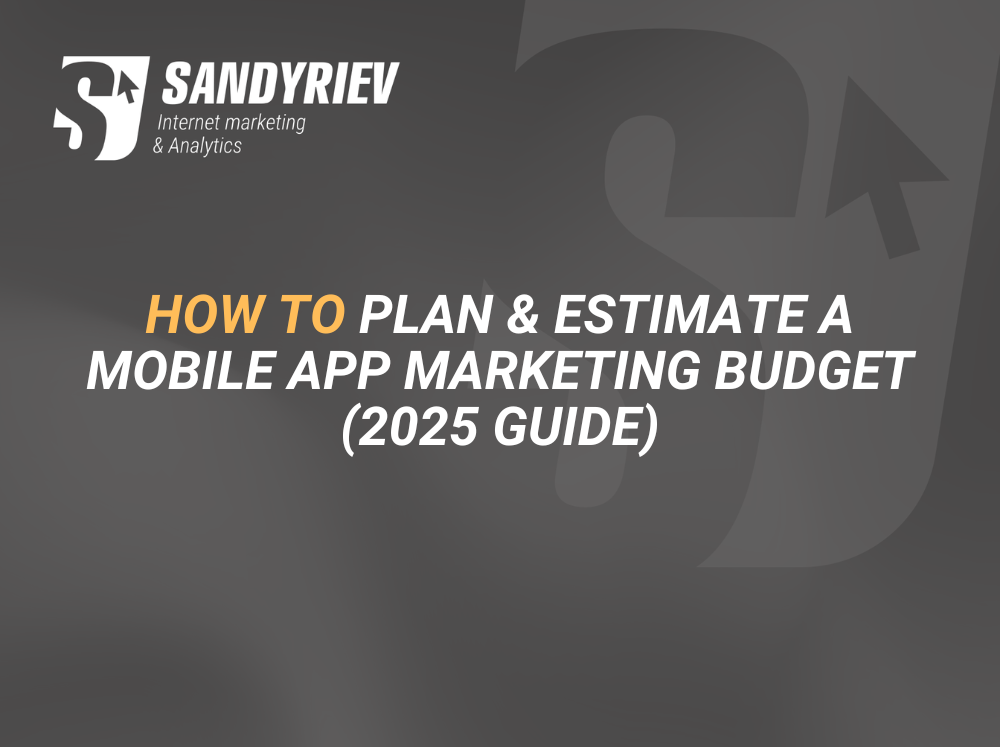
You’ve Built an App Nobody Will Ever Find Imagine this scenario: You stare at your analytics dashboard in disbelief. Three months after launch, your carefully crafted mobile app has exactly 47 users—42 of whom are friends, family, and beta testers. Your bank account looks even worse. You’ve spent $25,000 on development but allocated just $500 for marketing, assuming that “if you build it, they will come.” They didn’t. Maybe you’re about to face this exact scenario—pouring everything into building a mobile app while neglecting how you’ll actually get it into users’ hands. Or perhaps you’re being more strategic but still wondering: exactly how much should you budget for marketing your app, and where should you spend it? The painful truth is that without a real marketing budget, your app is effectively invisible in the $330 billion mobile app market. But randomly throwing money at the problem won’t work either. Today I’m sharing a comprehensive, data-driven blueprint for planning your app’s marketing budget—an approach that can save you thousands of dollars and countless sleepless nights by avoiding common pitfalls from the start. Let’s start by answering the burning question… Why Every Mobile App Needs a Marketing Budget (Even on a Shoestring) The cold reality: if you don’t allocate funds to marketing, nobody will know your app exists. Even amazing apps languish without promotion. Many industry experts recommend dedicating around 10–20% of your total budget or revenue to marketing efforts, especially for new apps. Established apps might spend a bit less proportionally (6–12% of revenue) as they rely more on organic growth. I’ve analyzed dozens of successful app launches and found the critical difference wasn’t necessarily how much they spent, but rather where and how they spent their marketing dollars. So how do you create a marketing budget that actually works? Let me walk you through the exact process based on my experience and extensive research. 5 Essential Steps to Plan Your Mobile App Marketing Budget 1. Assess Your Marketing Funnel The first crucial step is mapping out how users will move from awareness to install. This simple exercise often reveals gaping holes in marketing strategies that would otherwise go unnoticed. Start by visualizing each stage of your funnel: How will people discover your app? (ads, search, word-of-mouth) What steps lead them to download? Where do potential users typically drop off? For example, many app marketers discover that social media ads drive lots of awareness but few conversions, while Apple Search Ads often convert at 3× the rate. This insight alone can help reallocate budget to channels that perform better in later funnel stages. Your funnel analysis will highlight which marketing channels deserve the biggest chunk of your budget. 2. Define Your Goals with Brutal Specificity Vague goals lead to wasted budgets. Aiming for “lots of downloads” is an approach that leads nowhere. Instead, set SMART goals (Specific, Measurable, Achievable, Relevant, Time-bound): “Reach 10,000 installs within 90 days at a maximum CPI of $2.50” “Achieve 30% Day-7 retention rate by Q2” “Convert 5% of free users to paid subscribers within 30 days” Your goals will dictate budget priorities. For example, a subscription-based meditation app would allocate more to retention campaigns since subscriber lifetime value is the primary revenue driver. Meanwhile, an e-commerce app might focus 60% of budget on campaigns driving first purchases. 3. Account for Other Costs (Don’t Sink the Ship) This is one of the biggest mistakes app publishers make. Pouring every dollar into user acquisition ads without keeping the lights on is a recipe for disaster. Remember that marketing is just one portion of your app’s overall budget. You’ll need funds for: App development and updates Server costs Customer support App store fees (30% of revenue) Analytics tools Emergency reserves By calculating your non-marketing expenses first, you can determine how much is realistically available for marketing. A good rule to follow: never allocate more than 25% of available cash to marketing. 4. Identify Your Most Effective Channels Through Testing Don’t commit your entire budget upfront. Instead, implement what marketing experts call the “test and pivot” method: Allocate small test budgets across multiple channels Track performance metrics fanatically Double-down on winners, cut losers For example, with a $24,000 yearly budget, you might initially split it evenly at $2,000/month. After three months of testing, if you discover two channels are significantly underperforming, you could reallocate the remaining budget to the winners, potentially improving ROI by 40-50%. The key is to start small and scale what works, rather than committing to channels based on assumptions. 5. Track Key Metrics and Adjust Continually A marketing budget should never be “set and forget.” These critical metrics should be checked weekly: Cost Per Install (CPI): How much you spend to acquire one user Retention rates: Day-1, Day-7, Day-30 (percentage of users still active) Customer Acquisition Cost (CAC): Total marketing spend divided by new customers Lifetime Value (LTV): Average revenue generated per user If a campaign’s CPI exceeds your target or user LTV, it’s unsustainable. Be ruthless about reallocating budget from underperforming channels to winners. Monthly budget reviews and adjustments can save thousands in would-be wasted spending. Estimating Your Budget by Marketing Channel: Real Numbers Now for the million-dollar question: how much should you allocate to each marketing channel? Based on my experience and industry data, here’s a breakdown with real costs. Paid User Acquisition (Ads) This is typically the largest line item, especially during launch. It includes Google App Campaigns, Meta Ads (Facebook/Instagram), Apple Search Ads, TikTok, and more. Typical Cost Structure: Apple Search Ads: ~$1.42 per install Google Ads: ~$2.65 per install TikTok: ~$2.88 per install Instagram: ~$3.50 per install Facebook: ~$3.75 per install These figures vary by app category, targeting, and geography. US and UK campaigns often cost more than emerging markets. My Recommendation: Allocate 40-50% of your marketing budget here. For a $10,000 ad budget at a $2.50 average CPI, you can expect roughly 4,000 new users. Pro Tip: Lookalike audiences on Facebook and keyword targeting on Apple Search Ads can
Why “I Want More Leads” is Killing Your Marketing Success
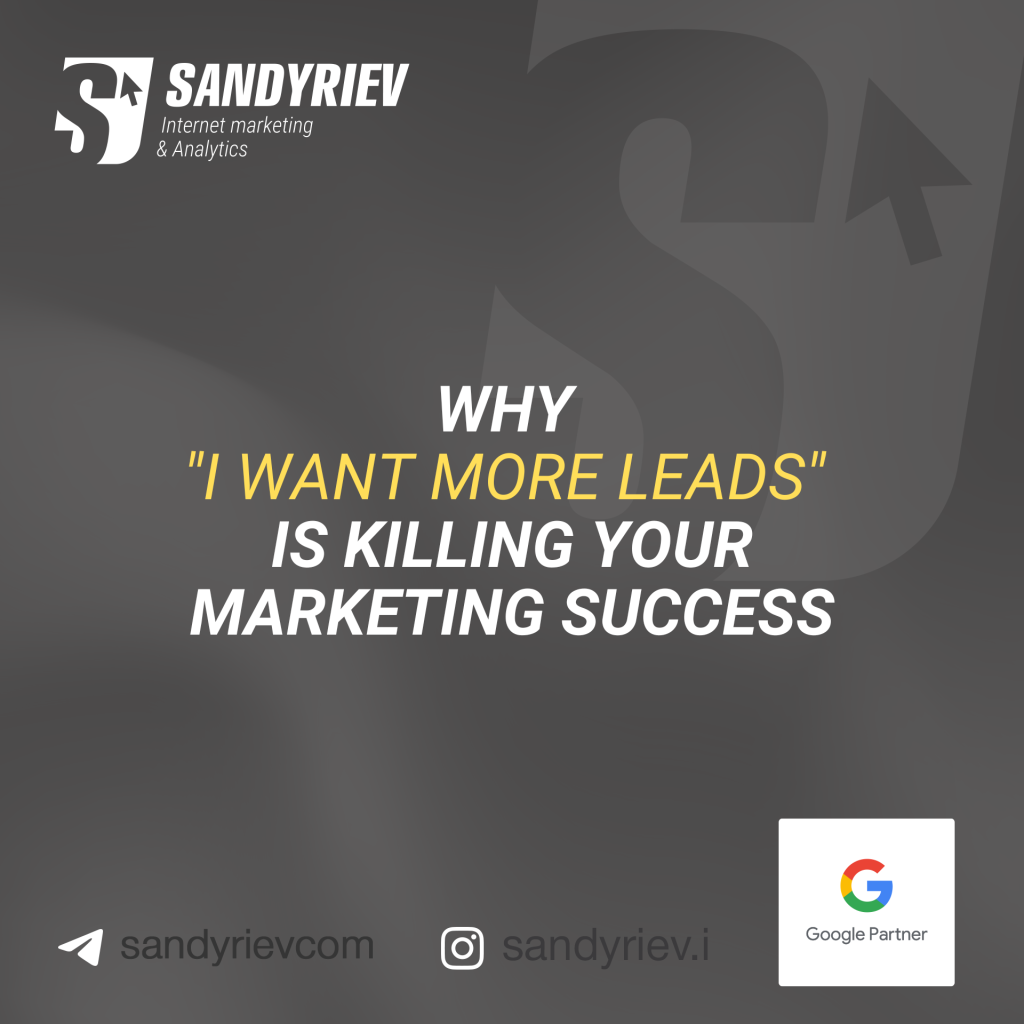
“We’re not seeing the results we expected.” These seven words strike fear into every marketer’s heart, often signaling the end of what could have been a fruitful partnership. Behind this all-too-common scenario usually lies one deceptively simple phrase: “I want more leads.” But what if the problem isn’t your marketing strategy or execution? What if it’s the goal itself? The Hidden Cost of Vague Marketing Goals Imagine pouring weeks into crafting and optimizing marketing campaigns, testing different strategies, and refining ad copy. Just as meaningful data begins to emerge, your client unexpectedly pulls the plug. This frustrating scenario happens more often than it should, and I’ve experienced it firsthand—twice. In both cases, clients expected immediate, large-scale results within just two months. These “unrealistic expectations” can almost always be traced back to that nebulous goal: “I want more leads.” The fundamental issue lies in how we set and measure objectives. A high volume of leads means absolutely nothing if they don’t translate into actual business outcomes like qualified opportunities, revenue, or profit. Understanding “Unrealistic Expectations” in Marketing Business owners often feel immense pressure to see immediate ROI from marketing investments. With tight budgets and growing competition, the desire for quick wins is understandable. However, marketing success—like any investment—requires clear expectations, proper tracking, and patience. Where Goal-Setting Goes Wrong Lack of Clear KPIs: A statement like “bring in more leads” doesn’t quantify success. Are you aiming for 50 leads monthly or 500? At what cost per lead? Without clear metrics, neither side knows what victory looks like. Uncertain Timeline: Marketing isn’t a quick fix. Meaningful and sustainable growth requires a well-structured approach, data collection, and optimization over time. Whether running PPC campaigns or pursuing SEO, realistic results often take months of testing, learning, and refining. Failing to plan for this adaptation phase leads to premature disappointment. Disconnect from Business Objectives: There’s typically an enormous gap between “more leads” and “increased revenue.” You might generate substantial leads, but if they don’t convert—or if the sales team can’t handle them—no real business growth occurs. The Dead End of “I Want More Leads” Vague goals create three significant problems: You Can’t Manage What You Don’t Measure: If you don’t specify how many leads you need or at what acquisition cost, you have no benchmark to determine if a campaign is underperforming or thriving. Budget and Timeline Issues: Without clear targets, it becomes impossible to plan an appropriate budget or set a realistic schedule. You risk overspending or underfunding key areas. Ineffective Optimization: To optimize a campaign, you need to understand where and how it’s succeeding or failing. A general call for “more leads” doesn’t reveal which segments, keywords, or ad groups are bringing the highest-quality opportunities. Transforming Goals with the SMART Framework To avoid these pitfalls, anchor your marketing objectives in the SMART method: S (Specific) Clearly define what you want to achieve. For example, a SaaS business may focus on increasing free trial sign-ups with a target cost per acquisition (CPA) of $20, while a local service provider may prioritize phone call inquiries from potential customers within a specific geographic area. M (Measurable) Establish quantifiable criteria. Are you tracking a 25% boost in leads within a particular timeframe? Do you need to keep the cost per lead (CPL) below a certain amount? A (Achievable) Goals should be within the realm of possibility given the historical data, budget, and market conditions. Stretching is good, but being realistic is crucial. R (Relevant) Ensure the goal aligns with broader business objectives. If your ultimate aim is higher revenue, your marketing goals should reflect lead quality, not just quantity. T (Time-Bound) Set a deadline. “Within 3 months” or “by the end of Q4” keeps both marketing teams and stakeholders accountable. SMART Goal Examples Weak Goal: “I want more leads.” SMART Goal: “I want to generate 30 new leads per month from Google Ads, with a cost per lead under $20, and convert 10% of them into customers within three months.” Weak Goal: “I want more Instagram engagement.” SMART Goal: “I want to increase Instagram engagement by 25% in 60 days by running a combination of Stories, Reels, and interactive polls, measuring success through comments, shares, and saves.” The Critical Importance of Accurate Goal Tracking Even perfectly set goals can collapse if you’re measuring the wrong data. Many advertisers track events such as button clicks or “click-to-call” actions but stop short of measuring business-level outcomes. Why Surface-Level Metrics Fail Clicks Are Not Conversions: A click on a phone number only tells you someone tapped the link. It doesn’t confirm if they actually spoke to your sales team or, more importantly, became a paying customer. Without Actual Sales Data, Marketing is Blind: Algorithms and marketing professionals need reliable feedback loops to optimize campaigns. If you only feed them clicks, they’ll optimize for clicks—often not the metric you truly care about. Improving Your Goal Tracking in 3 Steps Set Up Event Tracking: Use Google Tag Manager to track meaningful actions like form submissions, button clicks, and checkout completions. Use Call Tracking Software: Implement call tracking tools (e.g., CallRail, Phonexa) to tie phone leads back to specific ad campaigns. Integrate CRM with Ads: Connect your CRM (HubSpot, Pipedrive, Salesforce) to advertising platforms to track real revenue, not just clicks. The Sales and Marketing Partnership Generating leads is just the first step. How your sales team follows up, qualifies leads, and nurtures potential customers is equally important. Studies show that businesses responding to leads within the first 5 minutes see a 10x increase in conversion rates. If lead follow-up is slow or inconsistent, even the best marketing campaign can fail to produce meaningful results. Moving Forward: From Vague Goals to Clear Outcomes Business owners can improve their collaboration with marketers by clearly defining expectations, providing insight into their sales process, and aligning goals with actual business outcomes. Instead of assuming that marketers understand their end-to-end funnel, proactive communication about lead quality, conversion challenges, and revenue goals will create a foundation for more
Demand Gen in Google Ads & DV360: Full Breakdown for Performance Marketers
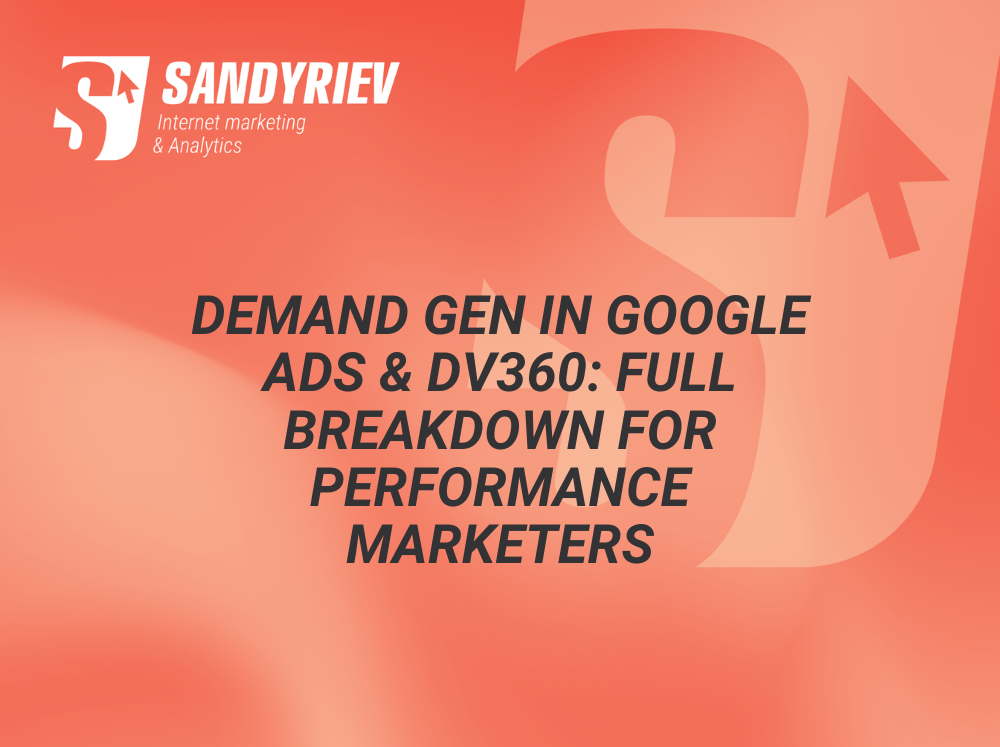
If you’re still running traditional Video Action Campaigns (VAC), you’re already behind the curve. Google’s Demand Gen is more than just a new campaign type — it’s a full-scale evolution of how we create, capture, and convert demand across the most visual surfaces of the internet. In this post, I’ll break down everything I’ve learned from the latest GMP Academy webinar, along with practical insights you can use immediately — whether you’re working in Google Ads or DV360. What Is Demand Gen? Demand Gen is Google’s latest AI-powered campaign type, designed to reach users when they’re not actively searching — through YouTube, Gmail, Discover, and now the Google Display Network. Unlike traditional campaigns focused on last-click conversions, Demand Gen plays strongly in the mid and lower funnel, offering powerful tools to: Generate interest Re-engage prospects Drive high-converting traffic It’s Google’s response to platforms like TikTok and Meta — but built around Google’s robust audience data and AI. What Happened to Video Action Campaigns? As of April 2024, you can no longer create new VAC campaigns in Google Ads or DV360. From July, Google Ads will begin automatically upgrading existing VACs to Demand Gen (DV360 will require manual transition). The transition is accompanied by Inventory Source Controls, allowing you to choose where your ads appear (YouTube Shorts only? Gmail only? Discover only? You decide). Why Should You Care? Because performance marketers need control. And Demand Gen now offers: Creative Synergy Combine video + image creatives in one campaign, and let Google optimize across multiple placements. Audience Power Use Google’s classic audience types, and now: Lookalike audiences based on your 1st-party data Adjustable reach from 2.5% to 10% AI-Driven Bidding Maximize Conversions Target CPA / ROAS Maximize Conversion Value New: Maximize Clicks (no conversion tracking required) Placement Transparency See where your ads are shown — Shorts, In-Stream, In-Feed, Discover, Gmail, or GDN. Results You Can Expect Based on internal Google data: +14% conversions when layering Demand Gen with Search or PMax +20% conversions when adding image assets to video campaigns +16% more conversions when enabling Google Display Network Norwegian Air boosted CTR by 77% and lowered CPC by 64% using Demand Gen via DV360 Best Practices to Launch Successfully 1. Budget & Bidding Start with at least $100/day Use Maximize Conversions for ramp-up Move to tROAS or Max Conv Value after ~50 conversions 2. Creative Setup Use both vertical and horizontal videos Add image ads — they boost performance significantly Use carousel or product feed if relevant 3. Audience Strategy Activate Lookalike Audiences Turn on Optimized Targeting Don’t be afraid to test broad vs. narrow reach 4. Testing & Optimization Let campaigns run 4–6 weeks before judging Aim for 50+ conversions in 30 days Run A/B/C experiments on creatives, audiences, and frequency caps DV360-Specific Advantages If you’re a DV360 user, Demand Gen fits beautifully into your centralized workflow: Full support for Floodlight attribution Unified reporting & bidding across channels Creative sync with YouTube Frequency capping across campaigns Structured data files (SDF) supported Final Thoughts Demand Gen is not a cosmetic update. It’s Google’s definitive answer to a more visually-driven, data-powered, AI-optimized advertising ecosystem. Whether you’re looking to scale lead gen, ecommerce, or app downloads — Demand Gen deserves a serious test in your strategy.